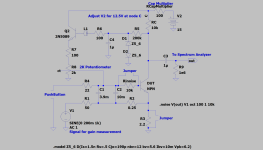Noise is a function of source resistance and collector current. See this graph from the 2N5087 datasheet.

Q1 is the only transistor whose noise matters. It is running at 70uA. Any high-gain, low noise transistor will have similar noise performance.
Ed
Q1 is the only transistor whose noise matters. It is running at 70uA. Any high-gain, low noise transistor will have similar noise performance.
Ed
There is equivalent input noise voltage and equivalent input noise current. Ideally you should test both, or test a combination of the two with a weighting that corresponds to what matters in your circuit - in other words, test the total noise with about the right source impedance.
Then again, if you only want to compare healthy and damaged transistors of the same type, it may suffice to only measure the current noise, or maybe even just the hFE at low collector currents. It's usually the 1/f noise associated with the base current that goes through the roof when the emitter-base junction was driven into avalanche breakdown. That kind of damage also causes a reduction of hFE at low currents.
The circuit Jack showed is clearly for measuring noise voltage rather than noise current.
Then again, if you only want to compare healthy and damaged transistors of the same type, it may suffice to only measure the current noise, or maybe even just the hFE at low collector currents. It's usually the 1/f noise associated with the base current that goes through the roof when the emitter-base junction was driven into avalanche breakdown. That kind of damage also causes a reduction of hFE at low currents.
The circuit Jack showed is clearly for measuring noise voltage rather than noise current.
To answer your question directed to me, in the NEC 2sa991 datasheet, they show a VTVM as a wide frequency response averaging AC voltmeter.
BP filter is a band pass filter involving your measurement bandwidth of concern. As specified 10-1kHz
Sounds like your AP substitutes as both a BF filter and ACV
BP filter is a band pass filter involving your measurement bandwidth of concern. As specified 10-1kHz
Sounds like your AP substitutes as both a BF filter and ACV
H&H indicate that I(noise) can be measured by inserting a resistor in series with the base of the DUT -- but they don't explain how.The circuit Jack showed is clearly for measuring noise voltage rather than noise current.
Voltage noise is measured with a short at the input. Current noise nees a resistance for the current to generate noise. Start with the voltage noise. Insert a suitable resistor (10K is enough for a bipolar transistor) and measure the increased noise. You then need to remove the voltage noise and the resistors intrinsic noise to get the current noise. The noises add RMS so its a little arithemetic. For a Jfet you need a much larger resistor to get a meaningful number.
If you are sorting for noise you don't need to care much about the absolute level. Just which transistors are really good, which are bad and the rest will be OK.
If you are sorting for noise you don't need to care much about the absolute level. Just which transistors are really good, which are bad and the rest will be OK.
- Home
- Amplifiers
- Solid State
- Test transistors for noise
